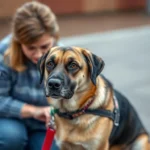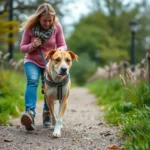
Introduction
Redirected aggression in dogs is a behavior that can be alarming for both pet owners and the dogs themselves. It occurs when a dog becomes agitated or aggressive toward an object, person, or another animal that is not the original source of its frustration. For instance, if a dog sees a squirrel and becomes overly excited, it may redirect that energy and aggression toward a nearby person or another dog, even if that individual was not the cause of its distress.
Addressing redirected aggression is crucial not only for the safety of other animals and humans but also for the dog’s mental well-being. Unchecked aggression can lead to injuries, legal issues, and a strained relationship between the dog and its owner. This article will guide you through understanding the nuances of redirected aggression, identifying its causes, and implementing effective strategies to mitigate this behavior.
Understanding Redirected Aggression
What is Redirected Aggression?
Redirected aggression is a type of aggressive behavior that occurs when a dog is unable to reach its intended target. Instead of acting out on the actual source of its frustration, the dog will turn its aggression toward something or someone else nearby. This behavior can be triggered by various situations, including encounters with other dogs, loud noises, or stressful environments.
It’s important to distinguish redirected aggression from other forms of aggression, such as fear aggression or territorial aggression. While fear aggression stems from a dog’s need to protect itself from a perceived threat, territorial aggression is driven by a dog’s instinct to defend its space. In contrast, redirected aggression is a reaction to frustration or overstimulation, making it unique in its triggers and manifestations.
Causes of Redirected Aggression
Common triggers for redirected aggression include encounters with other animals, sudden loud noises, or stressful situations such as visits to the vet. Dogs possess strong instincts and behavior patterns that can lead to frustration, especially if they feel unable to act on their impulses. Situational factors, such as leash reactivity and confinement, often exacerbate this behavior.
For example, a dog may become aggressive while on a leash when it sees another dog across the street but cannot reach it. This frustration can lead to redirected aggression towards the owner or another nearby dog.
Signs of Redirected Aggression
Identifying redirected aggression involves observing a dog’s behavioral indicators. Common signs include:
- Growling: A low warning sound that indicates the dog is feeling threatened or agitated.
- Barking: Excessive barking can signal frustration.
- Lunging: This sudden movement towards another object or dog indicates a loss of control.
In addition to these behaviors, pay attention to body language cues such as:
- Stiff posture: The dog may appear tense and rigid.
- Raised hackles: This is a sign of arousal and potential aggression.
Recognizing these signs early can help in effectively managing the situation.
Identifying the Root Cause
Assessing the Environment
To address redirected aggression, it’s essential to evaluate the dog’s surroundings and identify potential triggers. Look for patterns in aggressive episodes and consider factors such as location, the presence of other animals, and environmental stressors.
Understanding Your Dog’s Behavior
Observing your dog’s reactions can provide valuable insights. Keeping a journal of incidents can help you identify specific triggers and develop strategies to mitigate them. Note the context of each incident, including what happened immediately before the aggression occurred.
Strategies to Stop Redirected Aggression
Prevention Techniques
Preventing redirected aggression starts with creating a safe environment for your dog. Here are some techniques to consider:
- Create a safe space: Designate a quiet area in your home where your dog can retreat when feeling overwhelmed.
- Avoid known triggers: If certain situations or stimuli lead to aggression, do your best to avoid them.
- Use barriers: Employ baby gates or crates to manage your dog’s environment and limit exposure to triggers.
Training Methods
Training plays a crucial role in managing redirected aggression. Here are some effective techniques:
- Positive reinforcement training: Rewarding calm behavior can help reinforce a peaceful state of mind. For example, when your dog remains calm around a trigger, provide treats or praise.
-
Teaching alternative behaviors: Training your dog to perform alternative commands like “sit” or “stay” when encountering a trigger can redirect its focus away from the source of frustration.
-
Desensitization and counter-conditioning: Gradually expose your dog to triggers in a controlled manner while rewarding calm behavior. This process can help your dog become more comfortable in previously stressful situations.
Professional Help
If redirected aggression persists despite your efforts, it may be time to seek assistance from a professional dog trainer or behaviorist. These experts can assess your dog’s behavior and provide tailored strategies. Participating in group classes can also be beneficial, as socialization with other dogs can improve behavior over time.
Managing Redirected Aggression During Walks
Tips for Safe Walks
Walking your dog can be a challenge when dealing with redirected aggression. Here are some tips for safe outings:
- Use appropriate equipment: Harnesses and muzzles can provide added control and safety during walks.
- Strategize encounters: When approaching other dogs or stimuli, avoid direct eye contact and redirect your dog’s attention with treats or toys.
Techniques for Handling Aggressive Outbursts
If aggression occurs while on a walk, it’s important to remain calm. Here are some steps to take:
- Stay composed: Dogs can sense their owner’s anxiety, so maintaining a calm demeanor can help de-escalate the situation.
- Redirect attention: Use treats or toys to distract your dog from the trigger.
- Create distance: If possible, remove your dog from the immediate area to help it regain composure.
Long-term Solutions and Maintenance
Building a Positive Relationship
Creating a strong bond with your dog is essential in preventing redirected aggression. Engaging in activities like playtime and training can strengthen your relationship and build trust.
Ongoing Training and Reinforcement
Establishing a consistent training routine is vital. Regularly revisit training techniques to ensure their effectiveness and adapt them as needed based on your dog’s progress.
Monitoring Progress
Keeping track of behavioral changes is crucial for managing redirected aggression. Document improvements and setbacks to adjust your strategies accordingly. This ongoing assessment will help you fine-tune your approach and ensure that your dog continues to make progress.
Conclusion
In summary, understanding and addressing redirected aggression is key to fostering a harmonious relationship with your dog. By recognizing the signs, identifying the root causes, and implementing effective strategies, you can create a safer and more enjoyable environment for both your dog and those around you. Remember to be patient and persistent; behavioral changes take time, but with dedication, you can help your dog thrive.
FAQs
What is the difference between redirected aggression and other types of aggression?
Redirected aggression occurs when a dog cannot direct its aggression toward the initial trigger and instead acts out against a different object or individual. Other types of aggression, such as fear or territorial aggression, arise from different motivations and contexts.
How can I tell if my dog is experiencing redirected aggression?
Look for signs such as growling, barking, and lunging, as well as body language cues like a stiff posture or raised hackles. Keeping a journal of incidents can help you identify patterns related to redirected aggression.
What should I do if my dog shows aggression towards another dog while on a walk?
Stay calm, redirect your dog’s attention with treats or toys, and create distance from the trigger if possible. Consistent training and positive reinforcement can help prevent future incidents.
By understanding and addressing redirected aggression, dog owners can ensure a positive environment for their pets and foster a deeper bond based on trust and respect.









